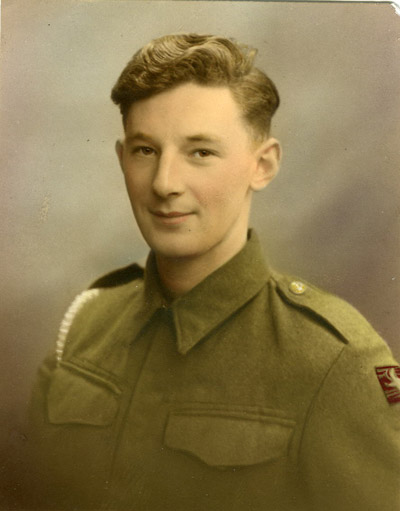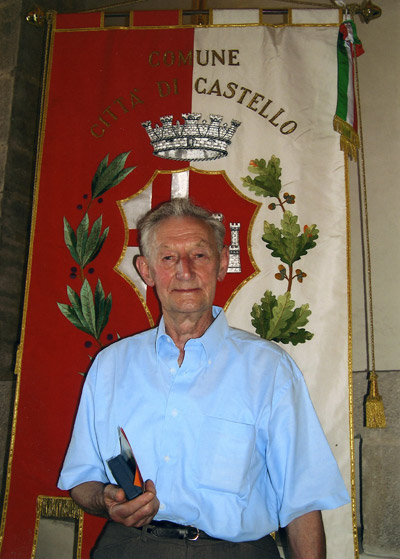Bert Goodwin, 1921 - 2018
Great
Paxtonians
A series of articles about people who have lived in Great Paxton or have a connection with the village.
Bert Goodwin was born in 1921 and raised in Great Paxton, he lived here until 1941 when he went to war, after which he came back to St. Neots. Though he never lived in Great Paxton again, he retained a strong connection with the village for the rest of his life and researched much of our history. If you have ever been on one of my history walks around the village, it is Bert’s research and memories that have formed their main basis.
Bert’s father was a tenant farmer in the village, they lived initially at Low Farm on Dovecote Lane, then Accommodation Farm on the High Street on the corner of London Lane. The name came from its use as temporary accommodation for itinerant farm workers when they were needed early in the year and later at harvest time.
As a young boy one of Bert’s jobs was to deliver milk from the farm both before and after school almost as soon as the cows were milked. Refrigeration was almost unknown so it was important not to have it standing around.
“On dry summer evenings when grass was scarce, my job would be minding cows by the roadside where they found fresh grass.”
“As there were so few cars one could enjoy the street as a playground for hoops, marbles and games with bows and arrows made from a willow stick, a piece of string and reeds from down the river.”
At 13 Bert left school and went to work as a labourer on a local farm. The job only lasted 3 weeks as he did not enjoy life on the land.
After some weeks he found a job as an errand boy at Flinders grocers shop close to St Neots Market Square, he was paid eight shillings for a 53 hour week. He gradually progressed to shop assistant. In 1936 he changed jobs to work for C.E Evans, a builder in Cambridge Street, St Neots, he enjoyed the work and learned the basics of bricklaying, painting and decorating. It was in the late 1930s that Bert met his future wife, Hilda, who worked for Lord and Lady Eltisley on the Croxton Park Estate.
Sometime between 1936 and 1938 (aged between 15 and 18!) Bert travelled to Spain to fight in the Spanish Civil War with the International Brigade. He returned to Britain after 6 months spent Canada before returning to Great Paxton. As preparations for the Second World War were made Bert took a maintenance job at the White House on Paxton Hill, where the firm making ‘Harley Landing Lamps’ for aircraft had relocated from east London housed in what had been a huge 5-storey battery chicken farm but now taken down to 3 storeys.
During the late summer of 1940 Bert joined a band of 42 local men initially called the “Parashots” but quickly became the “Home Guard”. Churchill had appealed to every town and village to form such forces mostly for defence mostly against any paratroops that might rain from the skies. After a month they were issued with 5 rifles and patrolled the high ground near Toseland Road in shifts.
By 1941 Mr Harley was losing staff to the war effort and though Bert wanted to join the RAF as an air gunner, he was asked to help out on the farm at Great Paxton, agriculture being a reserved occupation. Following further staff changes Bert was given the job of milking the cows, his least favourite farm job, he was now working 7 days a week with no time off. It was this turn of events that led him to join the army.
Bert went to Cambridge and enlisted in the 30th artillery regiment, he served in North Africa at Tobruk and the second battle of El Alamein where he was wounded and spent several months recovering largely in field hospitals. He spent a tour of duty (6 months) with the SAS but chose to re-join his old unit instead and fought in Italy at the battle of Monte Cassino as the allies drove the German army north out of the country.
Bert witnessed the death of his friend Yeshwant Ghadge of the British Indian Army in Italy who was awarded a Victoria Cross for gallantry. He pressed Indian and British officials to secure some support for his widow and later found that Yeshwant’s name had been omitted from a memorial in London. By Bert’s intervention his friend's name was added.
After the war Bert returned to St Neots and lived in Eynesbury for the rest of his life. On retirement he was able to indulge his passion for local history, transcribing wills and documents in Huntingdon Record Office, helping to found St Neots Local History Society and writing many informative articles for the society’s local history magazine.
Information for this article from Elaine Donaldson’s eulogy for Bert given at his funeral 9th February, 2018 and other articles printed in an issue of the St Neots Local History Magazine published in memory of Bert.
Bert's reminiscences of growing up in Great Paxton
You can read the fascinating story of Bert’s wartime service
in his book:
Tobruk to Trieste: Life of a Bofors Gunner 1941 - 45 by Herbert
W. Goodwin



